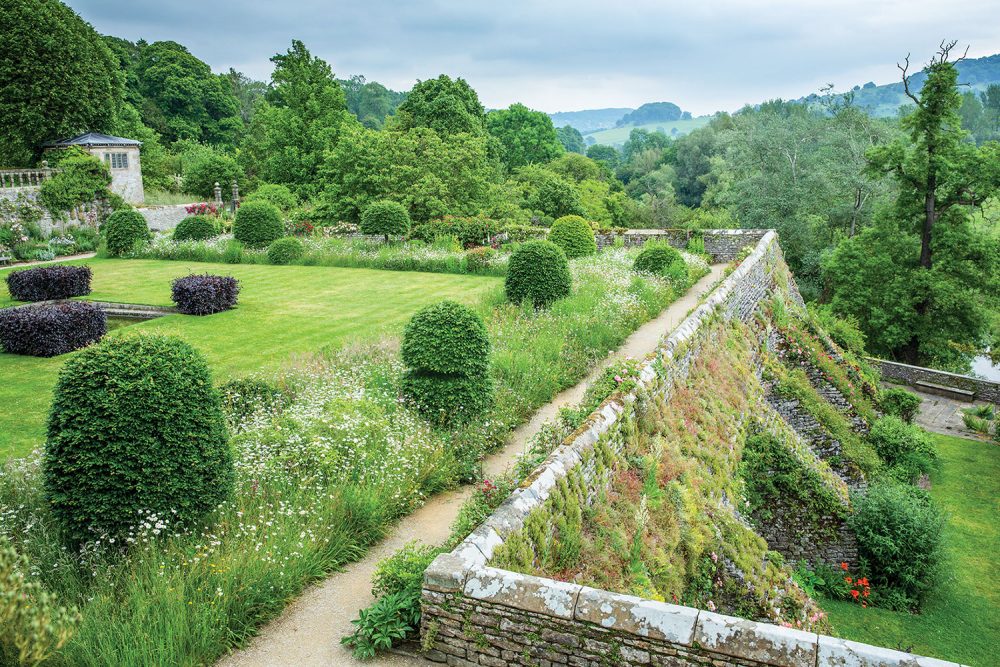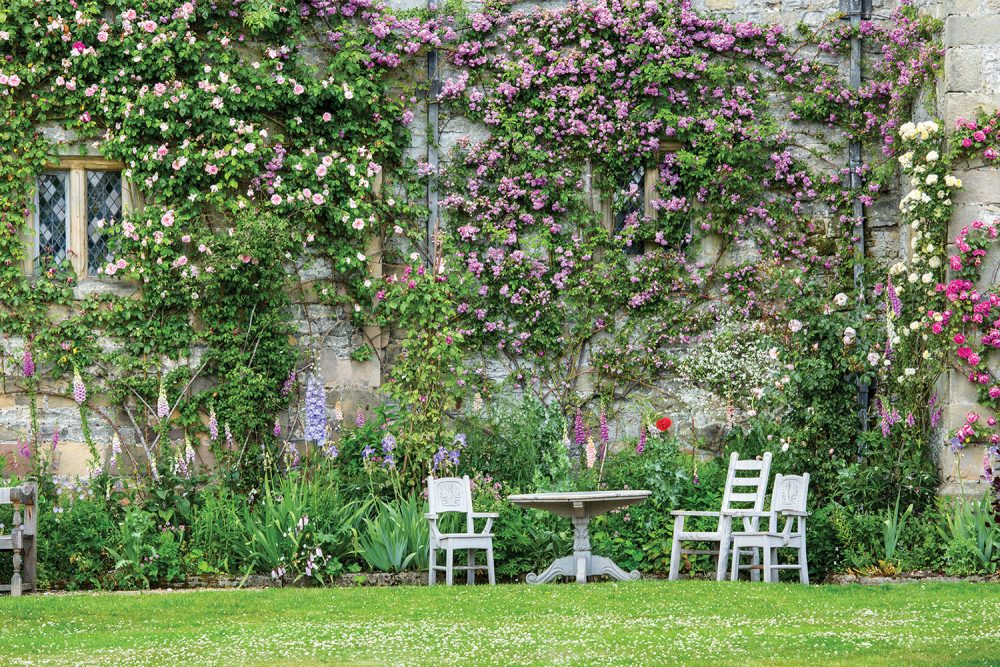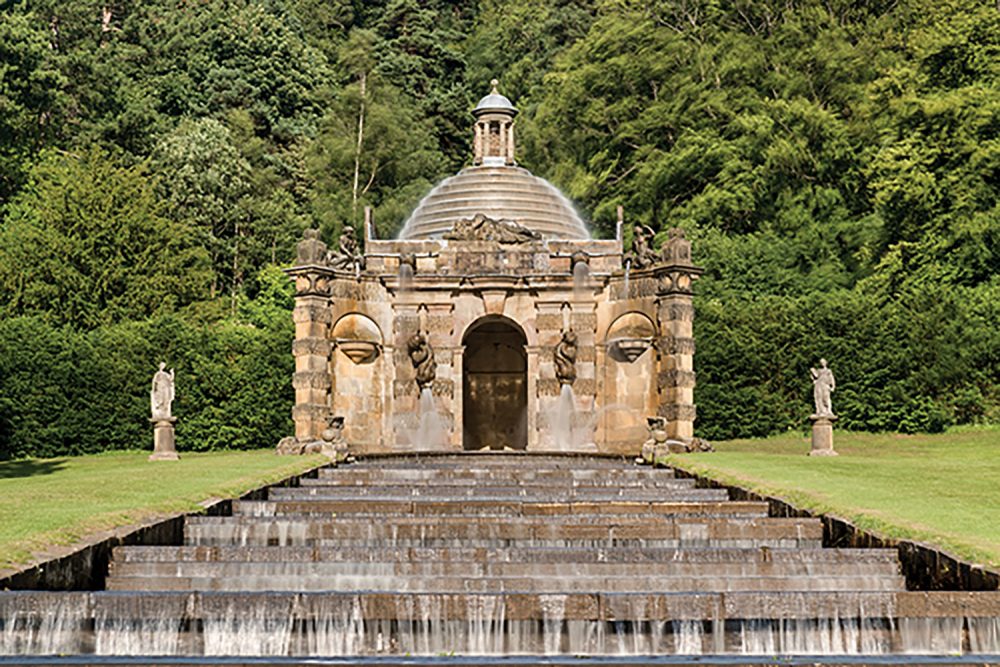
The austere stone façade of Haddon Hall ascends along a gravel path up a hill to its terraced, rose-filled gardens. The 3,800-acre estate includes parkland, a working farm, and 600 acres of woodland. Photo by Marianne Majerus
HADDON HALL
Crenelated 12th-century Haddon Hall perches on thick ramparts anchored on a limestone outcropping above the River Wye in Derbyshire. Dubbed “the most important English house to survive from the Middle Ages,” it lay dormant for 200 years, from the 1700s until the 1920s, when it was restored. Part of the duchy of Rutland, the 3,800-acre estate is owned by the present duke’s younger brother, Lord Edward Manners, who resides there with his young family. Today, happy shouts of energetic twin sons reverberate through passages, effectively erasing the Reformation’s darkness. But whispered tales recount the daring elopement of Dorothy Vernon, a Catholic, with Protestant Sir John Manners. Centuries later, their love story still resonates when one views the sweeping outdoor staircase that she supposedly used to escape from her disapproving father.“When you arrive at Haddon, you’re immediately struck by its formidable surrounds. It appears very masculine in its nature. However, when you walk through the gardens, you experience its breathtaking femininity. It is unbelievably beautiful and romantic, a real place for reflection.”—Lady Edward Manners

Thick masculine stone buttresses, softened by roses, clematis, and delphiniums, underscore the age of the Tudor building, which dates from the 11th century. Wide borders with topiaries and drifts of wildflowers make a dreamy setting for countless films, such as “The Princess Bride” and “Jane Eyre.” Photo by Marianne Majerus

A display of Haddon Hall’s roses includes ‘Scepter d’Isle,’ which blooms continuously all summer, emitting a myrrh-like fragrance; ‘Mannington Mauve Rambler,’ a vigorous rambler covered in semidouble mauve flowers; and ‘Président de Sèze’ roses, compact and deeply scented roses with lilac-pink blooms. Photo by Marianne Majerus
More Scenes from Haddon Hall
Click the arrows (or swipe if on a mobile device) to see more
CHATSWORTH
At first glance, Chatsworth House appears as a misty mirage, mirrored in the River Derwent, which bisects its 1,000-acre park. Aristocratic and aloof, the Elizabethan house is flanked by stables, greenhouses, gardens, grottoes, and mazes. A squat moated tower named Queen Mary’s Bower is a reminder that Mary Queen of Scots was once held there in the 1570s.
The 1st Duke’s greenhouse at Chatsworth, originally built in the 1690s when the garden was at its most formal, is one of the most important 17th-century greenhouses in England. Also called orangeries, they were used to overwinter citrus plants. Photo courtesy of Chatsworth House
“Chatsworth was described in the 17th century as a jewel, and a jewel it remains, making neighboring Haddon Hall all the more remarkable,” says British garden scholar and author John Phibbs. “How can it be that two great ducal houses should be a stone’s throw from each other?”

The famous Cascade was first created in the 1690s but took on its present wider and longer form in 1708, when Cascade House, designed by Thomas Archer, dominated the scene. Photo courtesy of Chatsworth House
More Scenes from Chatsworth
Click the arrows (or swipe if on a mobile device) to see more
WHERE TO STAY IN DERBYSHIRE
Lucky travelers to this beautiful corner of Derbyshire in the Peak District National Park have several well-appointed hotels and cottages to choose from, all within easy proximity of both estates.1. THE CAVENDISH HOTEL
A rambling stone building in the stylish village of Baslow, The Cavendish Hotel looks out on the countryside toward Chatsworth’s Hunting Tower. A pleasant stroll through the park’s open fields takes you to the main house, perched at the edge of the Chatsworth estate. Filled with original antiques intermingled with contemporary pieces and artworks plucked from the family’s collections, the rooms feature huge fireplaces. The tweed-jacketed staff can arrange cycling in the Peak District.2. Chatsworth Holiday Cottages
Located on the Chatsworth estate, the cottages offer a variety of private options, such as the 16th-century Hunting Tower, which sits over an escarpment 400 feet above Chatsworth House at the edge of Stand Wood. This fascinating vertical pile, completed in 1582 for Bess of Hardwick, may have been a banqueting or summer house but was also used by ladies to observe the working hounds in the park below. The tall, eerie-looking building with a spiral staircase sleeps four. The one-story Russian Cottage feels equally fairytale. Snuggled on a secluded road beyond Bluebell Woods, the charming building was inspired by a model of a Russian Farmhouse sent to the 6th Duke after the tsar canceled a visit to the estate.3. The Peacock at Rowsley
Near Haddon Hall, at The Peacock at Rowsley, Lord and Lady Edward Manners offer 15 beautifully appointed rooms and an award-winning restaurant. The 17th-century building has been a hotel since the 1830s—it’s pet-friendly, and sporting options, including fly-fishing on the River Derwent and Derbyshire Wye, can be arranged. Arne Maynard designed the picturesque riverfront garden.4. The Devonshire Arms at Beeley
Charles Dickens once favored this 18th-century coaching inn. Still popular with those who love its cozy bar and modern Brasserie decorated by the duchess herself, it is known for its locally sourced fare, including English cheeses, Derbyshire lamb, and Wye Valley asparagus. Fourteen comfortable bedrooms make it a perfect pausing destination.5. Fischer’s Baslow Hall
Find this boutique country-house hotel on the edge of the Chatsworth estate. Perched on the picturesque village of Baslow, the elegant manor offers 11 bedrooms and an award-winning restaurant specializing in local products such as Derbyshire pork, lamb, venison, and native fish with vegetables from the kitchen garden. Even if you are staying elsewhere, be sure to have a meal here during your visit.By Marion Laffey Fox



